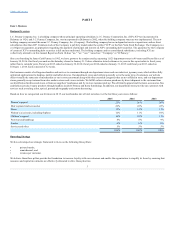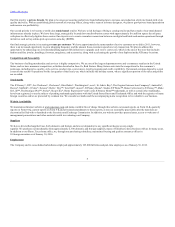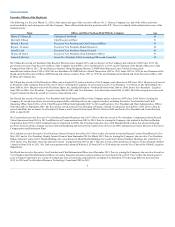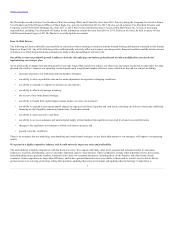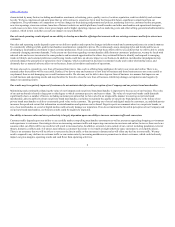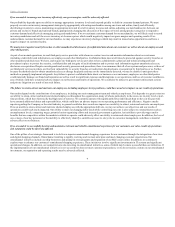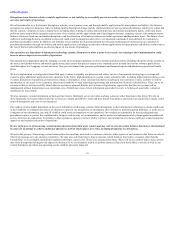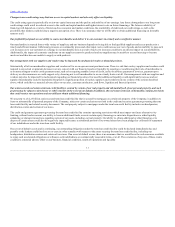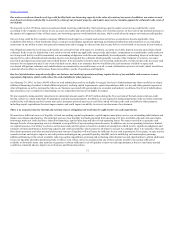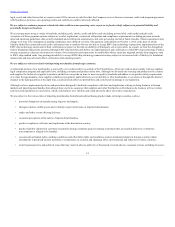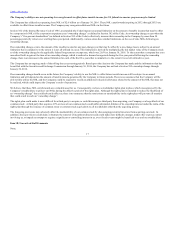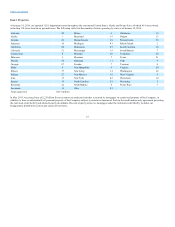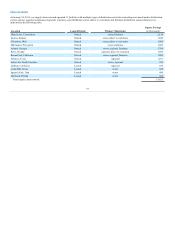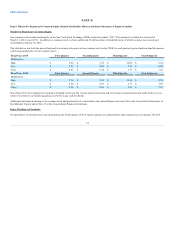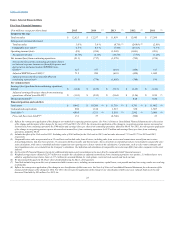JCPenney 2015 Annual Report Download - page 13
Download and view the complete annual report
Please find page 13 of the 2015 JCPenney annual report below. You can navigate through the pages in the report by either clicking on the pages listed below, or by using the keyword search tool below to find specific information within the annual report.
Table of Contents
Our ability to obtain any additional financing or any refinancing of our debt, if needed at any time, depends upon many factors, including our existing level
of indebtedness and restrictions in our debt facilities, historical business performance, financial projections, prospects and creditworthiness and external
economic conditions and general liquidity in the credit and capital markets. Any additional debt, equity or equity-linked financing may require modification
of our existing debt agreements, which there is no assurance would be obtainable. Any additional financing or refinancing could also be extended only at
higher costs and require us to satisfy more restrictive covenants, which could further limit or restrict our business and results of operations, or be dilutive to
our stockholders.
To reduce our exposure to interest rate fluctuations, we have entered into, and in the future may enter into, interest rate swaps with various financial
counterparties. The interest rate swap agreements effectively convert a portion of our variable rate interest payments to a fixed price. There can be no
assurances, however, that our hedging activity will be effective in insulating us from the risks associated with changes in interest rates. In addition, our
hedging transactions may expose us to certain risks and financial losses, including, among other things:
• counterparty credit risk;
• the risk that the duration or amount of the hedge may not match the duration or amount of the related liability;
• the hedging transactions may be adjusted from time to time in accordance with accounting rules to reflect changes in fair values, downward
adjustments or “mark-to-market losses,” which would affect our stockholders’ equity; and
• the risk that we may not be able to meet the terms and conditions of the hedging instruments, in which case we may be required to settle the
instruments prior to maturity with cash payments that could significantly affect our liquidity.
Further, we have designated the swaps as cash flow hedges in accordance with Accounting Standards Codification Topic 815, .
However, in the future, we may fail to qualify for hedge accounting treatment under these standards for a number of reasons, including if we fail to satisfy
hedge documentation and hedge effectiveness assessment requirements or if the swaps are not highly effective. If we fail to qualify for hedge accounting
treatment, losses on the swaps caused by the change in their fair value will be recognized as part of net income, rather than being recognized as part of other
comprehensive income.
Long-lived assets, primarily property and equipment, are reviewed at the store level at least annually for impairment, or whenever changes in circumstances
indicate that a full recovery of net asset values through future cash flows is in question. We also assess the recoverability of indefinite-lived intangible assets
at least annually or whenever events or changes in circumstances indicate that the carrying amount may not be fully recoverable. Our impairment review
requires us to make estimates and projections regarding, but not limited to, sales, operating profit and future cash flows. If our operating performance reflects
a sustained decline, we may be exposed to significant asset impairment charges in future periods, which could be material to our results of operations.
Synchrony Financial (“Synchrony”) owns and services our private label credit card and co-branded MasterCard® programs. Our agreement with Synchrony
provides for certain payments to be made by Synchrony to the Company, including a share of revenues from the performance of the credit card portfolios. The
income and cash flow that the Company receives from Synchrony is dependent upon a number of factors including the level of sales on private label and co-
branded accounts, the percentage of sales on private label and co-branded accounts relative to the Company’s total sales, the level of balances carried on the
accounts, payment rates on the accounts, finance charge rates and other fees on the accounts, the level of credit losses for the accounts, Synchrony’s ability to
extend credit to our customers as well as the cost of customer rewards programs. All of these factors can vary based on changes in federal and state credit card,
banking and consumer protection laws, which could also materially limit the availability of credit to consumers or increase the cost of credit to our
cardholders. The factors affecting the income and cash flow that the Company receives from Synchrony can also vary based on a variety of economic,
13


